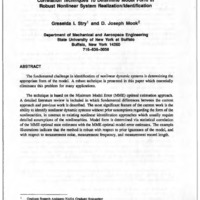Correlation Techniques To Determine Model Form In Robust Nonlinear System Realization/Identification
Item
- Title
- Correlation Techniques To Determine Model Form In Robust Nonlinear System Realization/Identification
- Report Number
- WL-TR-91-3078 Volume III, p. GCB-1 thru GCB-17
- Creator
- Stry, Greselda I.
- Mook, D. Joseph
- Corporate Author
- Department of Mechanical and Aerospace Engineering, State University of New York at Buffalo
- Date
- 1991
- Date Issued
- 1991-08
- Extent
- 17
- Identifier
- ADA241313
- Format
- 1 online resource
- Abstract
- The fundamental challenge in identification of nonlinear dynamic systems is determining the appropriate form of the model. A robust technique is presented in this paper which essentially eliminates this problem for many applications. The technique is based on the Minimum Model Error (MME) optimal estimation approach. A detailed literature review is included in which fundamental differences between the current approach and previous work is described. The most significant feature of the current work is the ability to identify nonlinear dynamic systems without prior assumptions regarding the form of the nonlinearities, in contrast to existing nonlinear identification approaches which usually require detailed assumptions of the nonlinearities. Model form is determined via statistical correlation of the MME optimal state estimates with the MME optimal model error estimates. The example illustrations indicate that the method is robust with respect to prior ignorance of the model, and with respect to measurement noise, measurement frequency, and measurement record length.
- Description
- The fundamental challenge in identification of nonlinear dynamic systems is determining the appropriate form of the model. A robust technique is presented in this paper which essentially eliminates this problem for many applications. The technique is based on the Minimum Model Error (MME) optimal estimation approach. A detailed literature review is included in which fundamental differences between the current approach and previous work is described. The most significant feature of the current work is the ability to identify nonlinear dynamic systems without prior assumptions regarding the form of the nonlinearities, in contrast to existing nonlinear identification approaches which usually require detailed assumptions of the nonlinearities. Model form is determined via statistical correlation of the MME optimal state estimates with the MME optimal model error estimates. The example illustrations indicate that the method is robust with respect to prior ignorance of the model, and with respect to measurement noise, measurement frequency, and measurement record length.
- Distribution Classification
- 1
- Distribution Conflict
- No
- DTIC Record Exists
- No
- Illinois Tech Related
- No
- Photo Quality
- Not needed
- Report Availability
- Full text available
- Type
- article
- Media
 ArticleGCB
ArticleGCB
Linked resources
Warning: Undefined array key "id_concat" in /var/www/html/omeka-s/themes/foundation/view/common/linked-resources.phtml on line 40
Warning: Undefined array key "property_alternate_label" in /var/www/html/omeka-s/themes/foundation/view/common/linked-resources.phtml on line 41
Warning: Undefined array key "property_label" in /var/www/html/omeka-s/themes/foundation/view/common/linked-resources.phtml on line 43
| Title | Class |
|---|---|
| Proceedings of Damping '91: 13-15 February 1991 San Diego, California (GCA-1 through JCB-17) |